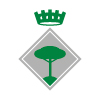- Català
- Español
- English
- Français
Places of interest
THE HIGH AREA
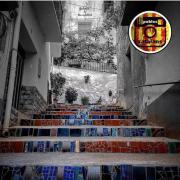
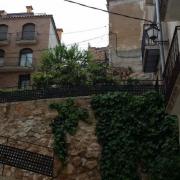
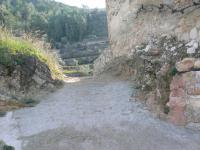
The high area include the streets at the top of the village. They are narrow, tortuous and steep. Located around a castle, now ceased to exist. They retain many characteristic elements of their moorish past.
PARISH CHURCH
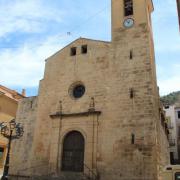
Located in the town's main square, it is dedicated to the Mare de Déu de l’Assumpsció and was built in 1635. In neoclassical style, it suffered damage during the Spanish Civil War that affected the wooden high altar of 'Baroque style’ (SXVIIII). It was later rebuilt. One of its Corinthian columns is used as a pedestal for a cross at the entrance to the village.
In the church you can also see a 13th century Virgin discovered in 2006.
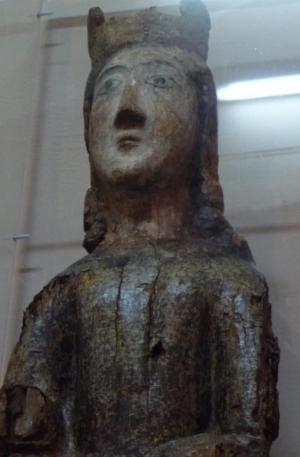
Located in the town's main square, it is dedicated to the Mare de Déu de l’Assumpsció and was built in 1635. In neoclassical style, it suffered damage during the Spanish Civil War that affected the wooden high altar of 'Baroque style’ (SXVIIII). It was later rebuilt. One of its Corinthian columns is used as a pedestal for a cross at the entrance to the village.
In the church you can also see a 13th century Virgin discovered in 2006.
Few towns or cities in New Catalonia, if any, can show off a sculptural jewel in a church like the one found by chance in Benifallet in 2006 hidden in the floor of the hermitage of the Mare de Déu de Dalt. She is a 13th century goddess who has nothing to envy in the Romanesque images of the Vall de Boí, considered a world heritage site, neither for artistic beauty nor for historical value. The Virgin of Benifallet is made by a polychrome wood carving in transition between Romanesque and Gothic, an "exceptional" fact, according to experts, because Romanesque liturgical art is practically non-existent in Terres de l'Ebre and New Catalonia in general. . The carving, 86 centimeters high per 35 centimeters wide, represents the crowned Mare de Déu, in a very hieratic frontal position, characteristic features of the Romanesque style. On the contrary, the folds of the tunic and the fact that the virgin holds the mantle with her left hand are more characteristic of the Gothic. His right hand is missing, and everything suggests that she was holding the baby Jesus, who was also missing.
There is an inventory of the art of the diocese of Tortosa made in 1935 by Bishop Manuel Milian Boix, and which speaks of a wooden carving of the Virgin in Benifallet that the religious dated to the fourteenth century, and states that everything indicated that it had been repainted. Thus, it is most likely that this found Virgin was hidden during the turbulent years of the Civil War under the floor of the hermitage, to save her from burning. What is surprising is that after the war no one remembered her again, perhaps because everyone thought she had been burned as well, until in November 2006, as if by a miracle, the coincidence made her reappear, as a result of a routine construction to change the floor of the hermitage of the Mare de Déu de Dalt.
For security reasons, the church in the center of the village was chosen to keep it, instead of the hermitage, the original space of the carving. On 31 January 2009, it was installed in a security window with an alarm in a side chapel in the parish church of Benifallet.
THE HERMITAGE
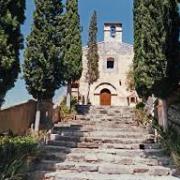
Located in the upper part of the village. It dates from the 13th century, with a Roman style, typical of the medieval Christian architecture of the Ebro region and linked to the Ordenis miliars that took part in the Christian conquest (Tortosa 1148). It is the old parish church, located on a large rock at the top of the village, which we access through a semicircular arch with perfect voussoirs.
It preserves two sarcophagi that, due to the text engraved on the outside, belong to the Pinyols, lords of Costumà, related to Benifallet during the Middle Ages, specifically in the 13th and 14th centuries. Today, we distinguish the primitive heraldic weapons of the family, as well as the respective Latin inscriptions. There are also frescoes, probably from the time of the construction of the church. In the Church, we find the image of the Mare de Déu de Dalt, patron saint of Benifallet. Its calvary stands out where there are small chapels that represent the life of Jesus Christ.
THE CONVENT

It is the most notable building in the town, in neo-Gothic style.
THE LAUNDRIES

Located on the banks of the river Ebro and next to the pier, the laundries are kept in very good condition and even today there are women who go to wash blankets and other large pieces of clothing. The english painter Amanda Corominas painted some mosaics.
MONUMENT TO THE LLAGUTER
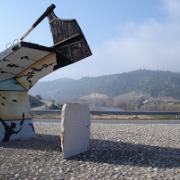
Located at the crossroads of the Ebro axis, painted by Clari, it is, as the poem of the local writer Francesc Cots says, "the homage of a village and a land that does not forget the work and the effort of the last navigators of the Ebro ".
SERRA DE CARDÓ
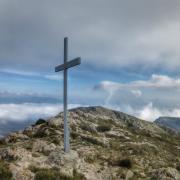
The Cardó mountains make up one of the most charismatic mountains in Terres de l'Ebre. Most of the massif extends between the municipalities of Benifallet (Baix Ebre) and Rasquera (Ribera d'Ebre). Its inner slope descends to the Ebro, to the south and south-east it continues along the Boix mountain range. The steep Cardó valley, open to the north-west, is drained by the Cardó ravine, a tributary to the left of the Ebro. Among the vegetation of the shady spot, holm oaks, pine forests and some oaks stand out. In the sunny area you can find shrubby vegetation such as mastic, rosemary or heather.
In this area, rainfall is scarce but the permeability of the limestone rocks gives rise to underground currents that give rise to medicinal springs that drain through the steep cliff of Sallent, crowned by the spa, and the old Carmelite convent of Cardó. The ridge culminates in the Creu de Santos (942 m) and is crossed by horseshoe paths that connected Benifallet and Rasquera with Tivenys and Tortosa. The old medieval villages of Sallent, Cardó and Costumà, in the north, and especially of La Fullola, La Bassa de Cascall have completely disappeared.
EL CARMULL
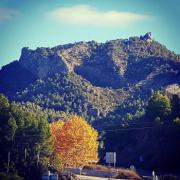
The Carmull hill, 425m, is a characteristic mountain of the Cardó mountain range located to the left of the Ebro. Its "banyetes" are seen from the region of Priorat. In addition to being an orographic symbol of Benifallet, it has served and still serves the villagers of the village as a magnificent sundial, because when the shadow line reaches the foot of the cliff it is 12 noon.
THE FOLLETERA ROCK
The Folletera Rock owes its name to the Triassic slates of its formation, which are presented in perpendicular thin layers. The Folletera Rock has also been called Penya dels Orguins because of its shape as organ pipes. In that place, on the left bank of the Ebro, there is the fountain of La Regina, of notorious antiquity. This Folletera Rock is also mentioned as a natural boundary by Ramon Berenguer IV in 1149, and was the jurisdictional boundary of Saracen Tortosa.
... Dono etiam vobi prata el paschuas et venationes et habetis hec omnia vo et omne succeores vetri post vos libere et ingenue cum omnibus ingressibus et egressibus sicut habentur et continenturper terram de Collo Balagerii usque ad Valldichona, et sicut pervadit de Rocha Faletera usque ad mother ... Letter of Population granted by Ramon Berenguer IV, Count of Barcelona and Prince of Aragon to the inhabitants of Tortosa. November 30, 1149
